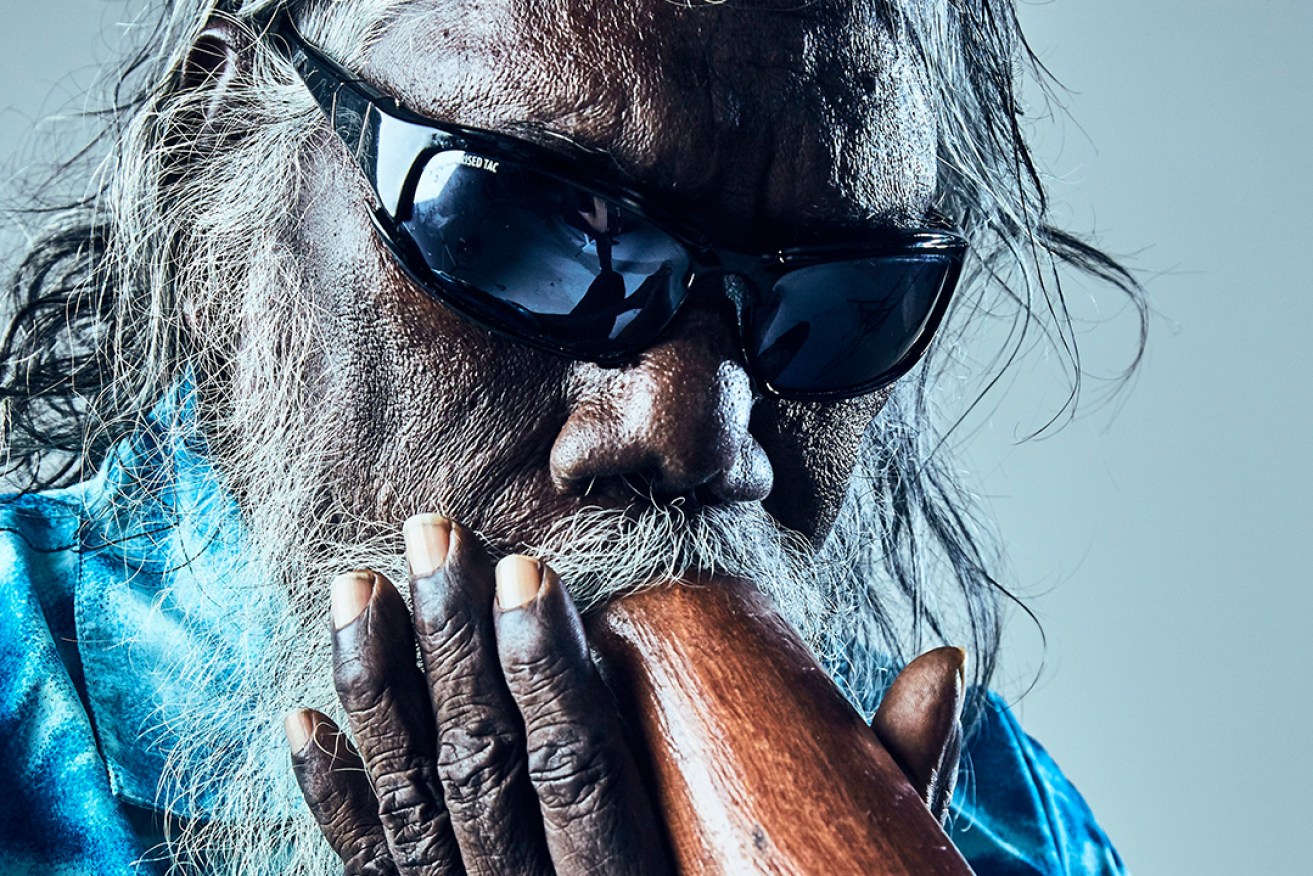
Yidaki – good vibrations at the SA Museum
Yidaki – Didgeridu and The Sound of Australia, on show now at the South Australian Museum, is a thrilling, blustering, utterly engrossing exhibition.

Djalu Gurruwiwi, Yolngu people, Galpu clan, Yidaki virtuoso with yidaki. Image courtesy South Australian Museum
The exhibition fits well with Adelaide’s designation in 2015as a City of Music by the UNESCO Creative Cities Network (UCCN).
Known globally as the ‘didgeridoo’ or ‘didgeridu’, ‘yidaki’ is the word used by the Yolngu Matha-speaking people of North East Arnhem Land.
Dozens of other words from Australian Aboriginal languages for this remarkable instrument criss-cross northern Australia, reflecting the high level of linguistic diversity in that region.
In this, the first major exhibition bearing his stamp, the SA Museum’s relatively new Head of Anthropology, John Carty, announces his presence as a dazzling iconoclast.
Professor Carty’s curatorial approach amplifies the instrument’s multiple meanings and overall significance by foregrounding the human, societal and environmental matrix in which the yidaki is embedded. Yidaki … thus fosters knowledge about this unique instrument that almost everyone has heard of, but knows little about.
Yidaki’s opening night was like no other at the Museum. Yolngu people were present in large numbers, contributing in substantive ways to audience understanding. Yolngu were positioned as the legitimate knowledge bearers, their knowledge and expertise unambiguously placed centre stage. Museum staff quite properly acted in humbler capacities as facilitators of this remarkable event.
These Yolngu yidaki players, performers and specialists, led by the grand old man Djalu Gurruwiwi (see lead image), yidaki master craftsman and maestro, co-owner of the west wind cycle, played the instrument, sang and danced. This made for an unforgettable ushering-in of the exhibition.
The exhibition covers all aspects of the yidaki.
For example, it demonstrates that natural species – the flora and fauna specific to Yolngu country – have significant parts to play, with termites playing vital roles in yidaki construction. The eminent musicologist Alice Moyle (1908-2005), has described this in the following terms:
…Didgeridoos are made from the trunk of a eucalyptus tree, which has been hollowed out by termites. The termites, or white ants, eat the heartwood of the host tree, and simultaneously create a nest within the latter using the tree’s digested wood fibre as their construction material. The instrument is made by stripping off the exterior bark layers, cleaning out any remaining portions of the nest, and applying a mouthpiece made from beeswax to the smaller end.
This termite-tunnelling/munching technique is also the initial stage in the making of Yolngu people’s celebrated vertical mortuary poles, larrakitj (also known by different names across Arnhem Land). Often called “hollow log coffins”, larrakitj are used as receptacles for the bones of deceased persons. They stand upright. Because they’re partly created by natural procedures, larrakitj come in idiosyncratic shapes and sizes, with lumps, bumps and nodules. Just like humans.
Once the termites have finished “dining in” on the interior of the logs, Yolngu paint rarrk (crosshatching designs) and other designs and sometimes figures onto the larrakitj indicating appropriate clan and moiety identity.
Thus nature is transformed into culture.
In important respects, Yidaki… challenges certain stale, although enduring, conventions of standard museological practice. At worst this be described as a necrological approach, with the Curator acting as Necrologist-in-Chief. While glass cabinets displays, for example, do have a place when a culture – say that of the Ancient Egyptians – is no longer extant, when cultural practices are alive and thriving as with Yolngu culture, there’s no excuse for such an approach.
Yidaki’s exhibits comprise large screens on which Yolngu custodians speak authoritatively in their first language (with English subtitles) fleshing out the broader context. Familial clusters of yidaki are on display. The mesmerising sound of the Yidaki permeates the galleries, allowing visitors to experience at a visceral level the interconnectedness of yidaki with other aspects of Yolgnu life, land and environment.
A video on a gigantic screen shows a mega-storm approaching coastal Yolngu country, slowly at first, but heading ominously towards the spectator, ominously culminating in a thundering explosion of yidaki accompaniment. This makes for an intense corporeal experience in which the yidaki soundscape, the deep rumblings of thunder, the flashing pyrotechnics of lightning and the vibrations that pulsate through one’s body merge. (Small platforms have been erected on which viewers are able to stand or sit resting their legs, enabling the yidaki vibrations to rise up through people’s bodies).
Particularly engaging is the cluster of yidaki displaying instruments at various stages of construction, beginning with examples in the early, immediately post-termite colonisation phase, along a continuum to beautifully adorned, finished yidaki. A large sign in bold letters adjacent to this installation reads “PLEASE TOUCH”. It came as a pleasurable shock, as it flagrantly transgresses normative museological practice.
Yidaki … brings in to play at least three of the five senses: sound, sight, and touch. The video of the storm gathering over Arnhem Land conjures up, somewhat synaesthetically, a sense of barometric pressure increasing, bringing the distinctive smell that precedes major storms. Of the senses, it’s the sound of the yidaki that is key, whether it’s violently energised , plangent or contemplative.
Go and see. It’s a wild, exciting ride.
To read more about the Yidaki: exhibition, go to the full article in The Conversation




